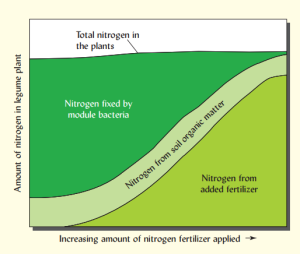Nutrient pollution
In 2009, ecologists determined that along with climate collapse and biodiversity loss, the nutrient pollution of nitrogen and phosphorus was the third of nine planetary boundaries to be crossed by 2009 due to the massive global use of synthetic fertilizers.[1]
Nutrient pollution is one of the most widespread, costly and challenging environmental problems, caused by excess nitrogen and phosphorus in the air and water:
Too much nitrogen and phosphorus in the water causes algae to grow faster than ecosystems can handle. Significant increases in algae harm water quality, food resources and habitats, and decrease the oxygen that fish and other aquatic life need to survive. Large growths of algae are called algal blooms and they can severely reduce or eliminate oxygen in the water, leading to illnesses in fish and the death of large numbers of fish. Some algal blooms are harmful to humans because they produce elevated toxins and bacterial growth that can make people sick if they come into contact with polluted water, consume tainted fish or shellfish, or drink contaminated water.
Nutrient pollution in ground water - which millions of people... use as their drinking water source - can be harmful, even at low levels. Infants are vulnerable to a nitrogen-based compound called nitrates in drinking water. Excess nitrogen in the atmosphere can produce pollutants such as ammonia and ozone, which can impair our ability to breathe, limit visibility and alter plant growth. When excess nitrogen comes back to earth from the atmosphere, it can harm the health of forests, soils and waterways. [2]
Nitrogen Pollution
Sources
The introduction of nitrogen fertilizers in industrial farming catalyzed a dramatic shift in soil agroecosystems worldwide from organic to inorganic nitrogen. Unlike organic nitrogen, most inorganic nitrogen is easily soluble in water and easily lost to from soils through leaching and volatilization.[3]
Impacts
Human Health
The inorganic nitrogen pollution of ground and surface waters is known to induce a variety of adverse effects on human health:
- Ingested nitrites and nitrates from polluted drinking waters can induce methemoglobinemia in humans, particularly in young infants, by blocking the oxygen-carrying capacity of hemoglobin. Ingested nitrites and nitrates also have a potential role in developing cancers of the digestive tract through their contribution to the formation of nitrosamines.
- In addition, some scientific evidences suggest that ingested nitrites and nitrates might result in mutagenicity, teratogenicity and birth defects, contribute to the risks of non-Hodgkin's lymphoma and bladder and ovarian cancers, play a role in the etiology of insulin-dependent diabetes mellitus and in the development of thyroid hypertrophy, or cause spontaneous abortions and respiratory tract infections.
- Indirect health hazards can occur as a consequence of algal toxins, causing nausea, vomiting, diarrhoea, pneumonia, gastroenteritis, hepatoenteritis, muscular cramps, and several poisoning syndromes (paralytic shellfish poisoning, neurotoxic shellfish poisoning, amnesic shellfish poisoning). Other indirect health hazards can also come from the potential relationship between inorganic nitrogen pollution and human infectious diseases (malaria, cholera).[4]
Remedies
Biochar
Due to its fine pore structure and adsorptive capacity, biochar can efficiently adsorb and remove excess inorganic nitrogen and phosphorous from soil, water, and/or waste to control environmental pollution.[5][6]
Ammonium (NH4+): Biochar has been successfully used for ammonium nitrogen adsorption - a major source of water eutrophication and pollution - from wastewater/poultry waste.[7]
Nitrous oxide (N2O): Studies have also found magnetized biochar to be particularly effective in removing excess inorganic nitrogen from soils, preventing the emissions of nitrous oxide, a major greenhouse gas and source of lethal air pollution.[8]
Mycelium
Sources
- ↑ https://commondreams.org/reaching-1-5c-global-heating
- ↑ https://www.epa.gov/nutrientpollution/issue
- ↑ https://www.pearsonhighered.com/assets/samplechapter/0/1/3/3/0133254488.pdf
- ↑ https://www.sciencedirect.com/science/article/pii/S0160412006000602
- ↑ https://www.sciencedirect.com/science/article/abs/pii/S095965262030620X
- ↑ https://www.sciencedirect.com/science/article/abs/pii/S0048969718344796
- ↑ https://www.researchgate.net/profile/Arvind_Singh56/post/What_is_remove_biochar_in_wastewater_treatment/attachment/59fb0fda4cde26d68ce667f6/AS%3A556225152262144%401509625818342/download/Ammoniumnitrogenremovalfromwastewaterbybiocharadsorption.pdf
- ↑ https://www.sciencedirect.com/science/article/pii/S0048969721065189
